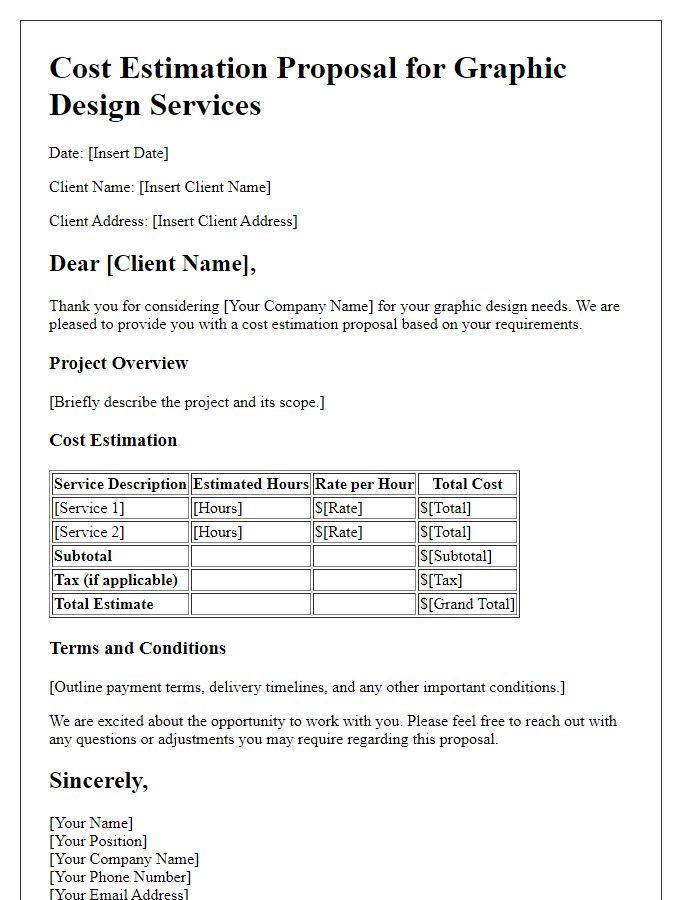When it comes to crafting a cost estimation proposal, it's essential to strike the right balance between clarity and professionalism. A well-structured letter not only outlines the expected expenses but also reassures your client of the value you bring to the table. Imagine receiving a proposal that is both informative and engagingâsomething that sparks excitement about the project ahead! Ready to learn how to create an impactful cost estimation proposal letter? Read on for detailed tips and templates!

Client Information
Client information is essential in a cost estimation proposal as it provides a comprehensive overview of the client's background, including company name, industry type and location. Accurate details such as contact person name, phone number, and email address ensure effective communication throughout the project lifecycle. Understanding the client's specific needs and objectives, including project scope and deadlines, allows for tailored cost estimates that align with their budgetary constraints. Noting previous projects or partnerships can enhance trust and credibility in the proposal, while any particular preferences or requirements expressed by the client can further refine the proposed costs and services, ensuring alignment with their expectations.
Project Description
The cost estimation proposal outlines the financial projections for the construction of a new community center in Springfield, a medium-sized city with a population of approximately 60,000 residents. This project, aimed at providing recreational facilities and social programs, includes a 20,000 square foot building featuring multipurpose rooms, a gymnasium, and outdoor spaces. Detailed breakdowns will address materials (such as concrete, steel, and eco-friendly insulation), labor costs, and equipment rentals, with the estimated budget projected at $3 million. The project timeline spans twelve months, beginning in June 2024, and aims to enhance community engagement and support local events, significantly benefiting the Springfield area. Key stakeholders include the local government, community members, and potential sponsors, all crucial to the project's success.
Detailed Cost Breakdown
A detailed cost breakdown is essential for providing transparency in project proposals. This breakdown typically includes consideration for labor costs, material expenses, overhead charges, and contingency funds. For instance, labor costs might account for approximately 40% of the total project budget, based on standard hourly wages of $25 to $50 depending on skill level and regional averages. Materials, sourced from suppliers like Home Depot or Lowe's, could range between $2,000 to $10,000, influenced by the project's scale and complexity. Overhead, encompassing utilities and office expenses, often represents around 15% of the total costs. Lastly, contingency funds, generally 5% to 10% of the budget, are crucial for unforeseen expenses that arise during project execution. Each category should be thoroughly documented to ensure clarity and trust between stakeholders.
Terms and Conditions
A cost estimation proposal's terms and conditions outline the framework guiding the financial dealings between the service provider and client. Crucial elements include the project scope, detailing precise deliverables and timelines, emphasizing the importance of timelines like a specified completion date (March 15, 2024). Payment schedules may indicate milestones, such as initial deposits of 30% upfront and remaining payments upon completion of specific tasks. Acceptance criteria outline the standards for evaluating project success, ensuring mutual agreement on quality expectations. Confidentiality clauses protect sensitive information, while dispute resolution procedures specify mediation or arbitration in specific locations, such as a designated venue in New York City. This legal framework safeguards both parties, encouraging transparency and trust throughout the project's lifecycle.
Contact Information
Cost estimation proposals require detailed breakdowns of project expenses, incorporating various elements, like labor costs, material expenses, and overhead fees. Essential components include the client's contact information - including full name, business name, address, phone number, and email address - which ensure clear communication. Including the proposal date and unique proposal identifier can enhance organization and tracking. Additionally, providing your own contact details, such as company name, address, phone number, and email, strengthens professionalism and facilitates responses. This structure is vital for maintaining clarity and efficiency in the budgeting process throughout the project's lifecycle.













Comments